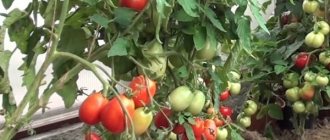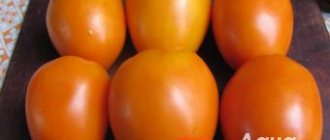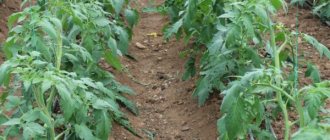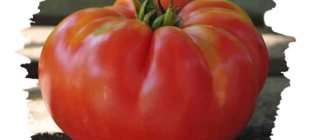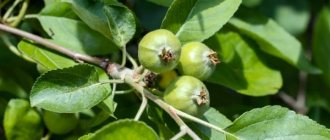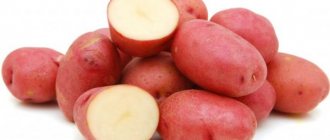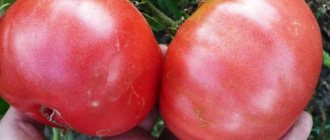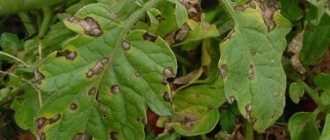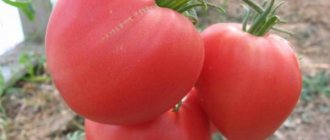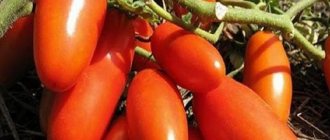Description of the Japanese tomato variety
This tomato belongs to the indeterminate type,
i.e., to the category of plants with unlimited growth. It is recommended to grow Japanese in open ground in the south of Russia, and in regions with a short summer period it is grown only in greenhouse conditions.
On a note!
The height of Japanese tomato bushes is about 2 m, so the shoots need to be tied to strong supports so that they do not break under the weight of ripening fruits.
Photo of Japanese tomato variety
Also, the bushes of this tomato require mandatory formation; usually they are grown into one or 2 shoots, and the remaining stepsons are removed as they appear. Most often, the first stepson is left, formed in the lower part of the bush, from which the second shoot will form.
The shoots of this tomato are erect, medium leafy. The foliage is medium in size, elongated, with short narrow tips, dark emerald in color.
Tomato Japanese, review - video
The Japanese tomato variety is classified as a mid-early variety.
– from the moment of germination of the seed material to the harvesting of the first fruits, 3-3.5 months pass.
The flowers are small, yellow in color, collected in racemose inflorescences, in each of which up to 5-9 ovaries are formed.
Mongolian dwarf
Plant dimensions
The Mongolian dwarf has an unusual bush structure.
First, the main shoot stretches upward, reaches a small height of 15 - 30 cm, and then bends sideways and bends towards the ground. The bush grows with short shoots, spreading out in all directions. It can occupy an area from half a meter to a meter in diameter. Mongolian dwarf is rightfully considered a super-determinate variety. The root system is superficial, branches not in depth, but in breadth. At first, young plants develop very slowly, then growth accelerates. Spreading shoots do not need garter, and there is no need to pin them down either.
Fruit
Such dwarf bushes produce unexpectedly large fruits, weighing about 200 grams. The average weight is also quite respectable - 170 grams. The tomatoes are round, raspberry-red. Taste is greatly influenced by weather conditions. Sometimes the pulp is a little sour, but quite pleasant, with a typical “tomato” aroma.
The fruit density is quite high. The tomatoes are fleshy, with a small amount of liquid, and transportable. The skin is dense, but can still be damaged by slugs, because the weighty brushes practically lie on the ground. When growing a Mongolian dwarf, it is necessary to lay a layer of mulch (straw, hay, agrofibre) under it.
The Mongolian dwarf variety is early ripening. The fruits begin to ripen very early, sometimes as early as late June - early July. Almost the entire crop turns red on the vine, even in the open ground of the Moscow region and Siberia. The bushes branch and constantly grow new ovaries. Fruiting lasts a long time, until frost. Mongolian dwarf tomatoes are tolerant of cold weather and drought, and resistant to bacterial and fungal infections.
Mongolian dwarf tomatoes are not yet sold in stores. The variety has no official status. Amateur gardeners share the seeds with each other. At first, this tomato was distributed in Transbaikalia and Siberia, and now it is grown by gardeners throughout Russia.
Description of fruits
Ripe tomatoes of this variety are heart-shaped with short sharp tips. The average weight of Japanese fruits is 300-350 g.
The first tomatoes that appear at the bottom of the bushes can weigh more than 400 g.
The skin of these fruits is quite thin, but strong, so it does not crack or get damaged when transported over different distances. The peel of ripe fruits is colored rich red with a pink tint.
Photo of Japanese tomato pulp
The pulp of ripe tomatoes of this variety is tender and meaty.
Interesting!
The taste qualities are high, the fruits of the Japanese tomato are sweet, there is practically no acid in ripe tomatoes.
Inside the pulp there are no more than 2-3 seed chambers, each of which contains a small number of seeds and a little liquid.
TOMATOES!
Tomato Sugar Bison Tomato BATYANYA Tomato Raspberry Flame F1
Characteristics of the variety
| Variety name | Japanese |
| Ripening period | Mid-season, 115-120 days |
| Bush height | 180-200 cm |
| Plant type | Indeterminate |
| Fruit shape | Heart-shaped |
| Color | Pink |
| Taste | Sweet |
| Weight | 300-350 g |
| Productivity | 5-6 kg per bush |
Amateur-selected varieties are not sold by large agricultural firms; they are purchased from amateur collectors and passed on to each other. The Japanese tomato is a mid-season indeterminate tomato. A plant with a thin trunk and medium foliage, requires obligatory garter. In greenhouse conditions, the bushes grow up to 2 m. The fruits are large, heart-shaped, with an elongated nose. The surface is slightly ribbed. The average weight of tomatoes is 300-350 g. But individual tomatoes weigh 500 g.
The color is deep pink, crimson. The pulp is fleshy, sugary in cut, sweet. The skin is thin and bursts when exposed to excessive moisture. Tomatoes ripen in bunches of 4 each. 6-7 brushes are formed on one bush. At the end of the growing season, the top of the stem is pinched. Stopping growth is necessary for the ripening of established tomatoes.
Area of application of fruits
Due to their sweet taste, Japanese tomato fruits are classified as dessert varieties and are used mainly for preparing vegetable salads and snacks.
Although these tomatoes do not crack when cooked, they are too large and not suitable for whole canning. Usually, sauces, juices and tomato paste are prepared from these fruits for the winter.
Pros and cons of the variety
The main advantages of the Japanese tomato variety include:
- seed material has almost 100% germination;
- tomato is resistant to major diseases and attacks by “harmful” bugs;
- high yields subject to agricultural technology;
- the variety does not require special care;
- The bushes of this tomato are compact;
- good taste of ripened Japanese tomato fruits;
- the harvested crop tolerates transportation well over different distances;
- tomatoes - large size.
It should be noted that the seeds of this variety can only be purchased from vegetable growers and collectors, and the cost of the seed material is quite high.
Tomatoes are starting to ripen. Variety "Japanese" 2021. - video
Transplanting seedlings
Seedlings need to be well looked after
If the Japanese variety is grown in open ground, then the seedlings need hardening. Within 2 weeks it should be taken outside, gradually increasing the time it stays. This way the plants get used to the outside temperature, and after transplanting the seedlings they will not experience stress.
Standard planting scheme: 4 plants per m². Compliance with this recommendation gives the maximum possible yield from each bush. You need to prepare greenhouse soil in the fall - disinfect it after harvesting and add all the necessary fertilizers - superphosphate and potassium salt. It is recommended to mulch the soil. Japanese is a heat-loving variety.
():
Japanese is a typical variety for the amateur garden. How do amateur varieties differ from professional varieties intended for cultivation on an industrial scale? The fact that they are not transportable and easy to store. Large fruits are found only in the first cluster. In industrial varieties, all the fruits are one-dimensional, the same size both at the first harvest and at the last.
Features of growing Japanese tomatoes
This tomato variety is grown only by seedlings. For further cultivation in greenhouses, seeds for seedlings are planted in the last ten days of February - the first ten days of March. And tomato bushes are transplanted to a permanent place at the age of 55-60 days in the first ten days of May.
If you plan to grow the Japanese tomato variety in open ground in beds in the garden, then the timing of planting seeds for seedlings and further transplanting seedlings to a permanent place will shift - it is thermophilic, so it should be planted only in well-warmed soil.
Planting seed material
Purchased seeds of this variety usually have undergone all pre-sowing treatment, so they do not need to be processed again before planting. It is only necessary to soak the seed material for germination in a growth stimulator.
Preparing soil and containers
Usually, to grow tomato seedlings, you buy a nutritious soil mixture for planting vegetable crops in specialized stores. But many vegetable growers prepare the nutrient substrate themselves, mixing garden soil, humus (or compost) and river sand. For looseness, sphagnum moss is usually added to such soil.
Home-prepared soil must be disinfected before placing it in containers.
Sequence of actions for soil disinfection:
- the soil is placed in an oven heated to 180 degrees for half an hour. Before use, such soil should be left at home for about two weeks so that the beneficial microflora is restored;
- spill the nutrient soil mixture with a weak solution of potassium permanganate. Once the soil has dried, it will be ready for use.
To plant tomato seeds, you must first take wide and low containers with drainage holes in the bottom.
To pick seedlings, you should prepare plastic cups, into each of which the plants will be transplanted.
Planting and further care of Japanese tomato seedlings
Seeds are placed in containers, deepening them 1-1.5 cm
. It is desirable that there be a distance of at least 2 cm between the sprouts. After planting, the soil is sprayed with a spray bottle, covered with polyethylene and put in a warm, bright place for germination.
Typically, shoots appear 6-8 days after sowing the seed. The film should be removed immediately and the temperature in the room reduced by 8-10 degrees to harden the sprouts. Then the temperature is raised again to room temperature.
When the Japanese seedlings have a pair of true leaves, they should be picked into separate containers
. A couple of weeks after picking, the seedlings are first fertilized with nitrogen-containing fertilizer for active growth of green mass. The seedlings are fed again 12-14 days before transplanting the plants to a permanent place.
10 days before planting Japanese tomato seedlings in greenhouses, they should be hardened. To do this, the plants are taken out into the fresh air for a short time at first, but gradually the time spent in the air is increased.
VEGETABLES:
White cabbage Golden Hectare 1432 Potatoes Aurora Carrots Flakke
Planting seedlings in a permanent place
No more than 4 plants are planted on each square of the greenhouse area. In this case, the Japanese tomato bushes will receive a sufficient amount of moisture and nutrients and will not interfere with neighboring sprouts growing and developing.
In the fall, greenhouses are prepared for spring planting work:
the top layer of soil is removed, replacing it with a new nutrient substrate (or the old one is disinfected), and the walls of the greenhouse are treated with a disinfectant solution.
After planting the seedlings, they should be watered abundantly.
Pest and disease control
The Japanese tomato has high genetic resistance to diseases. But there is a possibility of contracting some infections. The first sign is the appearance of brown and gray spots on the leaves. They should be removed immediately and burned to minimize spread.
Rules:
- Change the planting location every season, preferably planting after the beans.
- Change the top layer of soil annually.
- Spray young shoots of Japanese tomato with phytospore for disinfection.
- Monitor tomatoes closely and inspect them weekly for signs of damage. If they are present, remove these parts and burn. Treat neighboring plants with an antiseptic.
Further care for the Japanese tomato
This variety of tomato does not require special care, the main thing is to water the plantings on time, loosen the soil, remove weeds and apply fertilizer.
Irrigation regime
The Japanese tomato should be watered once every 5-6 days with filtered warm water. During periods of drought, the amount of watering is increased so that ripening fruits do not suffer from lack of moisture.
After each watering, the greenhouse should be ventilated so that the humidity in the room does not increase, which can provoke the development of fungal diseases.
Bush care
The bushes of this tomato must be formed into no more than 2 stems, and all other emerging stepsons must be removed.
Advice!
The shoots are tied to strong supports; if necessary, supports are also installed under the bunches with ripening tomatoes so that they do not break off under the weight of the fruit.
Loosening and weeding
After rains and watering, it is recommended to loosen the soil in the root zone of tomatoes in order to remove the dry crust that forms in a timely manner - it does not allow air to penetrate to the roots of the plants.
Simultaneously with the loosening procedure, all weeds in which insect pests can settle are removed.
Feeding
During the period of active growth of bushes, they must be fed with nitrogen fertilizers. And from the beginning of flowering until harvest, tomatoes must be fed fertilizers containing phosphorus and potassium.
How to grow
The Japanese tomato requires growing seedlings. At the time of disembarkation, she should be 2 months old. Those who have already planted this tomato recommend sowing it at the end of February. If we take into account the time required to wait for germination, March and April will remain for the development of Japanese tomato seedlings. In the greenhouse the soil warms up faster than outside; by the beginning of May it will already be warm enough for the tomatoes to successfully take root.
Growing seedlings
If tomato seeds were bought from collectors, then you will have to sow all the seeds - after all, there are very few of them. As a rule, they have already been selected for size and quality, so you can hope for 100% germination. To help Japanese tomato seeds wake up, we will additionally treat them with a growth stimulator. Usually, collectors' tomatoes do not get sick. The huge number of varieties does not allow planting many plants of the same variety, so each specimen is valuable. The gardener is obliged to take care of the health of the tomatoes and carries out all preventive treatments against diseases.
There are many different ways to do this. For tomatoes, the best option is soaking in aloe juice. In addition to possessing pronounced bactericidal properties, this miraculous plant is a powerful biostimulant for both people and plants.
In order for the juice to maximize its beneficial properties, aloe must be properly prepared. To obtain juice, leaves of a flower older than three years that have not been watered for 2 weeks are suitable.
To prepare the juice, the lower, completely healthy leaves are cut off. They are wrapped in dark cloth and kept for a week or two on the bottom shelf of the refrigerator. Then the leaves are ground in any convenient way and the resulting pulp is filtered and, if possible, squeezed out.
Soaking is carried out for 18 hours, completely immersing the seeds in the juice. It is better to do this in a bag of gauze or thin cotton fabric. After soaking, the seeds are not washed, but are sown immediately or germinated on damp cotton napkins, covered with a plastic bag.
we sow tomatoes in loose, slightly moistened soil to a depth of 2 cm, you can sow them in one container, but it is better to place each seed in a separate small pot;
We lay a 2 cm thick layer of snow on top; usually there is still a lot of it in February. Melted snow will saturate the soil with melt water, which stimulates rapid seed germination and will have a beneficial effect on future plants. All that remains is to put plastic bags on the containers with Japanese tomato seeds and put them in a warm place; shoots will appear quickly - on the 4th or 5th day, they really need the maximum amount of light, otherwise the thin shoots will stretch before our eyes, they do not need a lot of heat at this stage of development, it is enough to maintain a temperature of about 16 degrees during the daytime and 14 degrees at night ; in about a week, the Japanese tomato seedlings will get stronger, grow roots and need a different temperature regime: 22-23 degrees during the day and 18 at night; water the tomatoes, soaking all the soil in the pots, but only when it dries
Excessive humidity harms tomatoes - it provokes blackleg disease, in which case it will be difficult to save the seedlings. Tomatoes of the Japanese variety, planted in separate pots, do not need picking; they will need to be transplanted into pots or glasses with a volume of at least 700 ml, and preferably 1 liter, preserving the earthen ball with roots; do this when the Japanese tomatoes have 4 or 5 true leaves; In order for Japanese tomato seedlings to grow in quality, they need sufficient nutrition: 2 or 3 feedings with a weak solution of mineral complex fertilizer every 2 weeks; Plants need to be fed starting from the formation of the first true leaf, at which time the nutrients contained in the seed run out and Japanese tomato plants require external feeding; an important event - hardening of seedlings; Of course, in the greenhouse the conditions for plants are more comfortable than outside, but they are different from those in the room, so that the plants do not experience stress when they suddenly change, we accustom them to them gradually, this will take 2 weeks.
Japanese tomatoes: reviews from those who planted and grew the variety
Vladimir, 65 years old, Vladivostok: I purchased seeds of the Japanese tomato variety by accident from a summer resident breeder. I liked the variety - it is productive, does not require special care, and the fruits are very tasty. I left the seeds to grow this variety in the future.
Lyuba, 44 years old, Perm region: In my greenhouse I try to grow varieties of tomatoes that do not require special care and are highly resistant to disease. One of these varieties is the Japanese tomato. I bought seeds a couple of years ago from a neighbor in his summer cottage - a little expensive, of course, but the variety was worth it. Later I began to collect my own seed from these tomatoes. And now every year I plant my seeds for seedlings - I plant a couple of beds with this tomato every year.
Nikolai, 55 years old, Orenburg: My mother-in-law gave me Japanese tomato seeds a couple of years ago to plant in my greenhouse. She planted them in open ground, but the tomatoes “didn’t work” - the variety turned out to be too heat-loving. And in my greenhouse the bushes grew tall, actively and fruitfully bearing fruit. From now on, every year I will allocate space in the greenhouse for this variety.
Characteristics of the variety
Based on their descriptions and characteristics of the Japanese tomato variety, one can note the high yield of the crop. This variety is capable of producing fruits until the first frost.
Productivity and fruiting
The Japanese tomato variety is formed into 1 or 2 stems. Productivity is quite high. From 4 to 10 tomatoes can ripen on one bunch. It is worth noting that the largest fruits are located on the lower branches. This variety is most often grown in greenhouse conditions.
Area of application of fruits
Japanese tomatoes are very sweet, so they make an excellent base for fresh salads. It is impossible to preserve such fruits due to their large size - tomatoes do not fit into a jar. However, you can make delicious tomato juice or paste from these tomatoes. Due to the high sugar content in the fruit, the juice from Japanese tomatoes is simply amazing.
Resistance to diseases and pests
Japanese tomatoes have high immunity against fungi and other diseases. However, there are situations when tomatoes are affected by fungi and insect pests, but this is often due to improper care.
Advantages and disadvantages of the variety
Japanese tomatoes have many advantages that do not leave any summer resident indifferent.
Advantages of growing Japanese tomatoes:
- high germination of seed;
- resistance to diseases and insect pests;
- when grown correctly, they bear fruit abundantly;
- ease of care;
- compactness when placed in a greenhouse;
- excellent taste of fruits;
- good transportability;
- large, sweet fruits.
The variety has only 2 disadvantages, but they are significant:
- It’s quite difficult to purchase - only those who like to collect different varieties have such tomatoes;
- high cost of seed - for 10 grains sellers require about 100 rubles.
However, based on the reviews and photos of summer residents, we can safely note that the Japanese tomato is a very productive variety, and these shortcomings cannot in any way cover up the advantages of the crop.
